Khao Yai National Forest/Portraits and Photoshop Filters

|
Feature Photograph

This photograph was taken inside Khao Yai National Forest. This image is significant because of what you can’t see in this first image. What you can’t see at this screen size is detail!
The contrast of the wooded part of the tree against the small lake is interesting but normally this wouldn’t make for a picture you’d want hanging on your wall. However, if the image was say.. 20 x 30 inches and the image exhibited so much detail that you just wanted to keep running your eyes over it from one end to the other to observe all the detail, well.. then you have something worthy of display and discussion!
How much detail? Look at the 1:1 crop below.

In last week's piece I devoted 100% of the piece to “Critical Focus” and I consider this topic to be very important. Important enough that I’ll be hitting on it every chance I get in future columns. Critical Focus results in critical or extreme sharpness, and this sort of sharpness brings out interesting detail you’ll never see in photographs of the same subject otherwise captured.
It’s a bit like walking over the same patch of grass everyday and thinking there is nothing special about this patch of grass. Then one day you stop and sit. While sitting you’re that much closer to the grass and you start to notice things like the patterns of the blades of grass, ant hills, all types of insects, and if you put your ear real close to the grass on a breezy day.. you’ll find that the wind cutting through the blades not only has it’s own scent, but it also makes a music you’ve never heard before..
Khao Yai National Forest
Khao Yai National Forest is just a few hours outside of Bangkok and more than worth the drive. Mostly you’ll see many more Thais than foreigners in the forest, and during our time there we say very few visitors period. You’ll start to climb in elevation as you near the entrance to the forest and the surrounding scenery is remarkable!
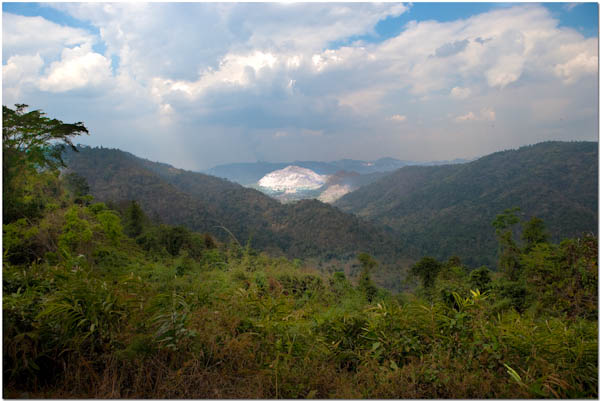
At the park's entrance there is an information center where you can check the fire danger level, water tables, weather, and ask any questions you may have. There are also plenty of brochures available for free. The entrance fee is 40 baht for Thais and foreign locals, and 400 baht for tourists. I’m very specific about the way I worded the last sentence because the signs at the park are not. If you have a work permit stamp in your passport, a retirement visa, a marriage visa, or even a local drivers license, all you need to do is show it at the collection point and you’ll only be charged 40 baht. This holds true throughout Thailand at the many national parks and attractions I’ve visited.
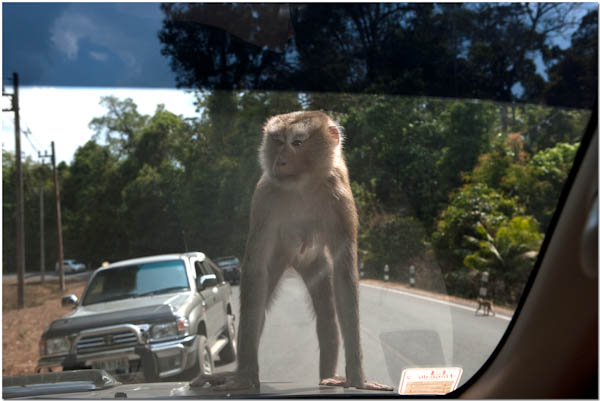
Just a few kilometers inside the forest you’ll see monkeys by the side of the road and cars stopped with the occupants feeding the monkeys and taking their pictures. Two weeks ago I ran a “Portrait Head Shots”
learning section in this column and this is where I captured those images. The smaller monkeys are very friendly and will hop up on your car to see inside.

I think they’re looking for food. Once they determine you have food they’ll be very polite and sit on your side view mirrors and gently reach in as you hand them the food.
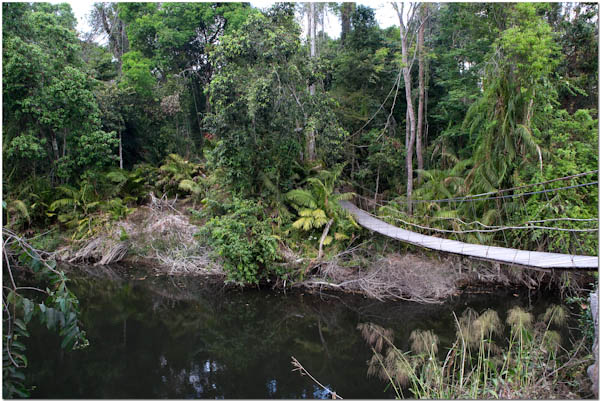
There are many waterfalls not far off the road. In some cases you’ll need to cross a swinging cable bridge over water.
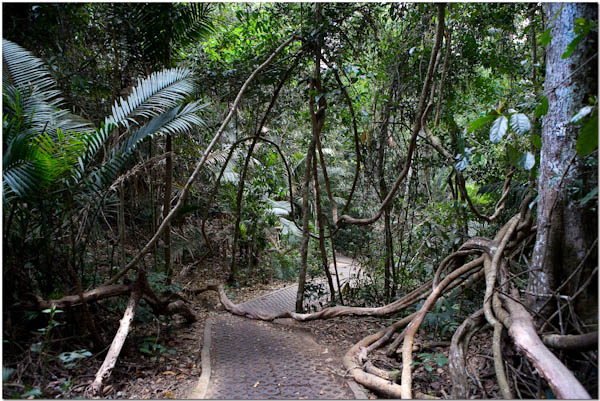
The pathways to the waterfalls are sometimes paved, but many are in a state of disrepair.
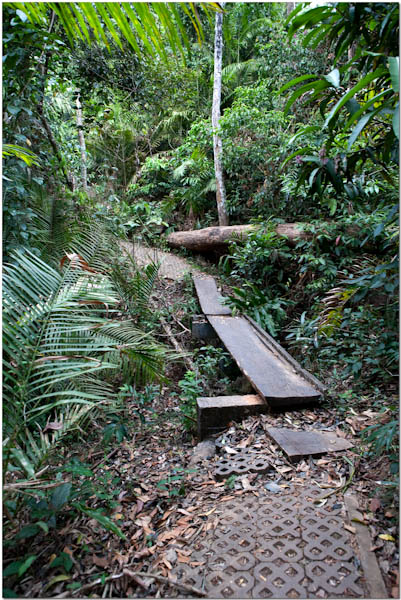
In areas where the pathways have been washed out you’ll usually find some sort of improvisation available to keep you on track.
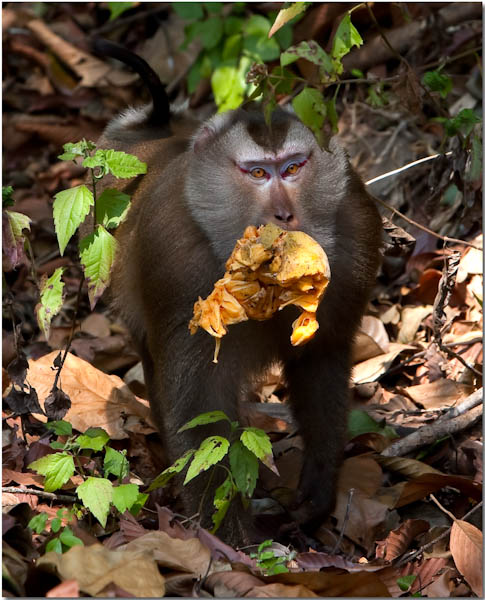
Further into the forest you’ll find large species of primates. These are actually quite large and powerful animals, but they seem very peaceful and non-aggressive. Still, primates can be set off by many things we can’t predict or understand so exercise caution.
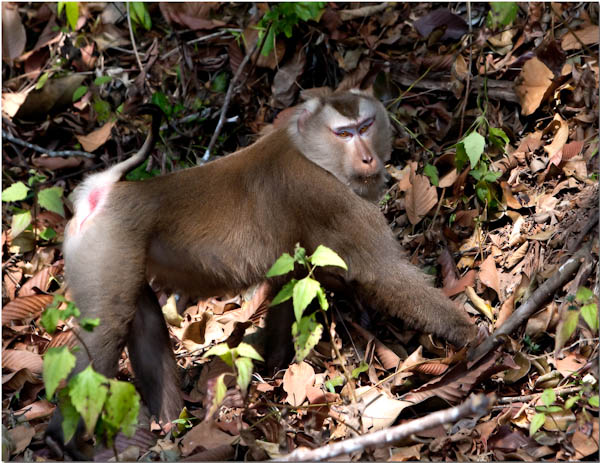
These guys would stay within range of my 70-200/2.8 IS lens, and if you moved slowly and approached them with respect you’d often get close enough for some detailed images.
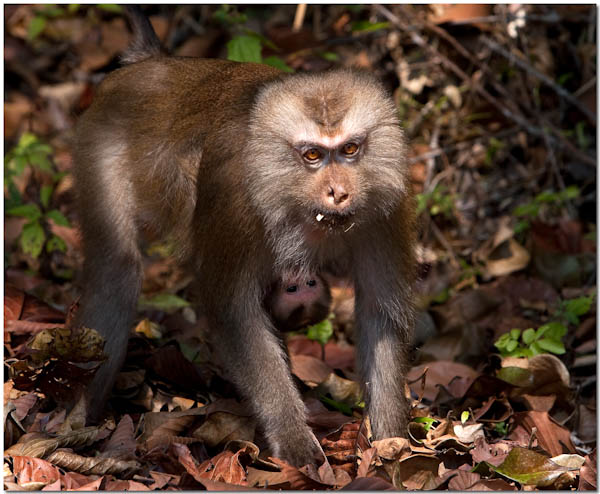
The females carry their newborns around clinging to their underside. In this image you can see the newborn's face and eyes looking out from under the mothers chest. The mothers will let you get quite close, probably hoping for food. Mothers can be very protective and unpredictable.
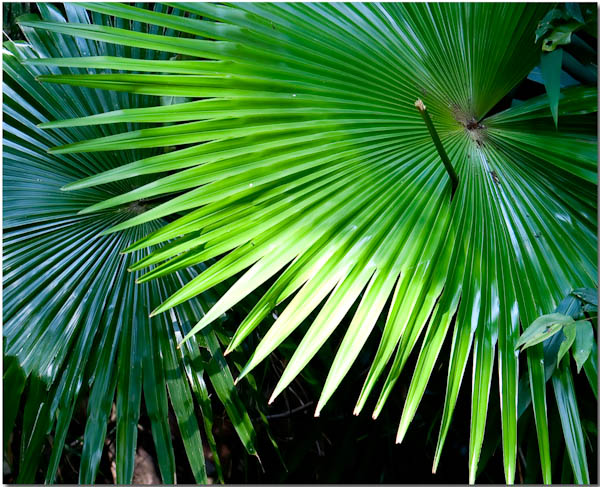
All through the forest you’ll see delicious flora and fauna and contrary to most locations where the best time to photograph is at sunrise or sunset, the best time to photograph a jungle or high canopy forest is during the midday when the sun is directly overhead. It’s during this time that certain areas of the canopy will allow actual sunlight to filter through in a directional manner and produce some interesting images.
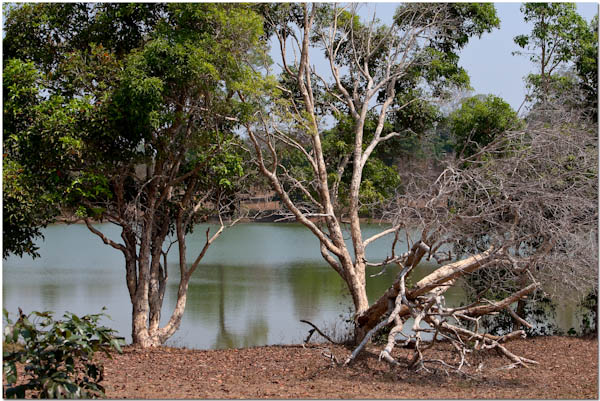
There are many natural and man-made bodies of water. Reservoirs are common in the forest and are strategically built and located so as to have water available to fight fires and supply the major waterholes for the abundant wildlife population which ranges from elephants to monkeys, and there’s even rumors of some tigers in the furthest reaches of the forest.
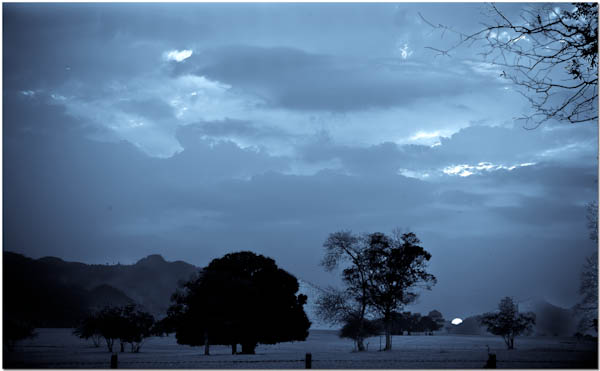
You’ll find lots of landscape opportunities and you might be tempted to create a split-tone version like I did above.
It’s hard to believe that you can leave the pollution laden concrete jungle of Bangkok, and in just a few hours be walking down a path in a pristine national forest, but this is the reality which makes Khao Yai National Forest such a treasure. I hope you find time to visit.
Portraits and Photoshop Filters
Last week a good friend called up and asked if I could stop by his work and photograph a young Thai lady who was weeks away from the birth of her first child. Often times I’ll agree to such a shoot because it keeps me in practice and it’s good to spread some goodwill every now and then. In this case it was especially satisfying because I was getting the chance to serve a young lady who otherwise could not have afforded to pay a photographer on her own.
The workplace was very average and industrial in appearance. Basically what you’d expect from any Thai workplace. Whiteboards hanging on the walls, refrigerators with pots and pans set on the top, boxes and bags of ‘stuff’
against the walls, and of course that wonderful florescent lighting which makes portraits so warm and colorful (that was sarcasm folks.. ;o). In other words it was the worst possible environment
/ backdrop for an emotional type of portrait.
I didn’t want to disappoint this young lady so I sat there and studied what was available and ultimately decided to take advantage of some natural backlighting coming through some glass tiles, and that Photoshop filters would be the only way to mask the clutter and starkness of the workplace. Looking around for a stool I had to settle on an old box and it was on the box top I placed her in the best location I could find. Posing her the best I could, we produced the following raw image by angling in directional light on her face and belly using my off-camera portable strobe manually adjusted to expose her face and belly, while using the camera to expose the background 2 stops under (the natural backlighting was very bright).

As you can see post processing this into a decent emotional pregnancy portrait is going to take some work!
The first thing I did was to decide on black and white toning. Actually, my friend requested this and because it fit my goals it was an easy decision.
Studying the image there were a few things I noticed which I didn’t care for. The writing on the whiteboard, visible books, bottles, fridge, ugly box we were using as a stool, and her legs were swollen and discolored and probably not anything she wished to remember. So.. I started with a strategic crop and adjustment of the levels keeping in mind her desire for an 8×10 perspective.
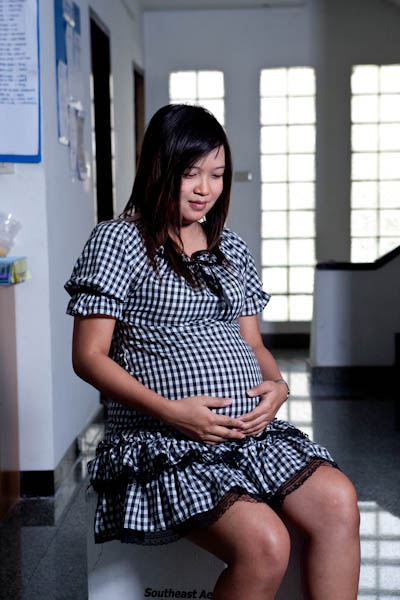
Now that I had a nice cropped image I had to deal with the distractions in the frame still remaining, and do my best to give it an emotional “mood..”
After some selective dodging, burning, and feathering I had darkened the areas around her legs, the bookcase, and the far walls and ceiling.. and then it was time to use Photoshop’s Filters menu to add some selective blurring with some motion added. The resulting final image appears below.
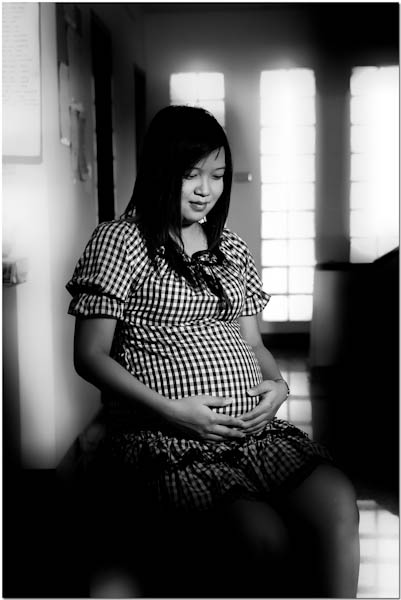
I was careful not to blur her features, and to not overdo the blur. During dodging and burning I focused the light on her face and belly in a sort of glow.. and blurred outwards from these areas. I’m pleased with the resulting image, but only because I know what I started with and what I started with wasn’t pretty (the background, the girl was plenty pretty).
The most important objective, pleasing the client, I accomplished. Feedback reveals her to be very happy with her portrait. This makes me happy…
Photography News of Interest
The downturn in the world’s economy has claimed Ritz Camera, the largest US camera store. They’re filing for bankruptcy protection under Chapter 11. You can read about it here.
Samsung might make great televisions and other appliances, but they’ve been slow to come up with quality digital cameras. They might have turned this around however. As PMA starts today (March 3rd) Samsung announced something really different!!! A point and shoot camera with a APC-S sized sensor, the same sized sensor used in the Nikon D300, D90, and Canon Rebels, and 50D! But, in a very small compact point and shoot body with a EVF (electronic viewfinder) vs. an optical viewfinder, and a removable lens. I wouldn’t run out and buy one of these yet, but it is the first of its kind and bears a good look at the reviews when they come out. You can read about it here.
Do you live near Long Island? ExploreLI Magazine is looking for photo submissions for a special cover. There are three main prizes. You can read more about it here.
Whiskeytown and cemeteries.. how can you resist a series of photographs from this interesting location? Read about it here.
I want my COLORMUNKI!!! Seriously. I’ve been using X-rites products for years to color profile my displays and it appears they’ve just combined over $3000 worth of profiling tools and software into one easy to use $499 package. I’ll be trying to get my hands on one of these to review and hopefully purchase for my own use. Image Resource reviewed the ColorMunki and their review was quite favorable. If you’ve been wanting to purchase profiling hardware and software you’ll want to check out their review here.
Canon has released Auto Focus firmware and hardware fixes for their 1d3 series professional bodies. The autofocus problems with these bodies are going on their 2nd year so lets hope Canon gets them right this time. This has really been handled poorly by Canon and has been a motivating reason for many to turn to Nikon’s excellent D3 series. You can read more about this here.
Readers' Submissions
Hi Steve,
I went to the Dusit Zoo yesterday and here is a photo of a white egret I took just has it was taking off from a perch.
Also a photo of a mere cat.
These have not been worked on and just were resized.
Charles

|

|
Charles –
It looks like you’re having fun with your new lens! Nice pics!
Animals are a lot of fun to shoot..
Steve
I suspect the readers' submissions will be a highly anticipated section of this column and I encourage anyone with photographs and travel accounts they d like to share to please send them to me at: QandA@Bkkimages.com
Readers' Questions
Hello Steve,
I've just read your article on the Damnern Saduak Floating Markets. Very good and it looks like we photographed the same stall seller.
You're right about wanting to go back there a few times, now that I've been there I and taken some photos of the place and seen my photos, I want to go back to take some more from different angles.
I am still looking for a good 2nd F2.8 lens though, as 3 days ago I went to the Dusit Zoo and got talking to a Thai who had a 70-210 sigma f2.8 APO lens on a Nikon D80 and he gave me a lend of it to take a few photos of some mere cats and it was incredible the difference in the quality. So I'm going to scratch and save to buy a f2.8 lens. Don't know if it'll be such a big lens or just a smaller one.
I've been looking at these type of lens! Can you guide me if they are any good!
Sigma 18-50mm F2.8 EX DC MACRO Lens for NIKON D-SLR
or this one
SIGMA 70-210mm F2.8 APO AF
Nikon F5 film camera and F2.8 80-200 lens (good buy, even without camera)
Charles
Hi Charles –
Sigma makes very decent 70-200 lenses. Do your research though because some series are better than others. You’ll want a HSM APO 70-200.
I wouldn’t touch Tokina or any of the others.
Canon has the advantage of offering a 70-200 F4 lens which optically is superb. Price wise it’s cheaper than the Sigma.. they have a more expensive IS version of the same lens. I’m predicting that Nikon will be coming out with their own cheaper F4 version soon.. but no telling how long.
Steve
Steve if you had to choose between a 24> 60mm F2.8 and a 50> 150 f2.8 lens, which would you buy. I am torn between the 2 and can only buy one.
I like the 50 to 150 as I can take portrait and also get close to animals but the 24 to 60 would give me portrait and landscapes also.
Charles
Charles –
This question depends entirely on your specific needs. I really can’t answer it for you.
I can tell you, that for my uses, I use more 50mm and above than below.. but it’s close because I’m a wide angle freak and I love using my telephotos for wildlife..
Take a close look at how these lenses overlap the focal lengths you already own.. and perhaps this will help.
Steve
After taking some sample photos from both lens I decided to buy the Sigma f2.8 50 to 150mm APO lens, it cost me 18,000 baht with a new UV filter on it.
Charles
Charles –
I hope you enjoy the new lens! I’ll look forward to some seeing some images from it!
Steve
Please submit your questions to QandA@Bkkimages.com All questions will be answered and most will show up in the weekly column.
A Snapshot of Bangkok Images Week in Review
This last week has been very busy. No workshops, but I traveled to Trat for a wedding, did an on-location portrait, and continue to work on the design for my website.
I also visited Beung Boraphet Wildlife Preserve and Wetlands in Nakhon Sawan with some good friends and will cover this trip more in depth in next weeks column. For now you can check out the new gallery on my website showing this fantastic place. Check out the gallery here.
Infocus Blog
The Audacity of it All
This was going to be a rant, but instead.. well.. I suppose this is going to be a rant.. ;o)
I have a good friend who occasionally admires my photographs. Like everyone else of our generation she has her own point and shoot compact and to her credit she’s noticed a difference in the photographs she takes, and the photographs I take.
She has even asked me to “give me a few pointers so I can make photographs like yours” and “ I just read your Critical Focus piece, can I borrow your camera so I can make photographs like yours.”
Can you already see the problem?
She’s a popular professor of music at the top university in Thailand and a conductor of choirs and orchestras. She plays and teaches piano at a very high level.
My response to her was “Can I borrow your piano, and can you give me a few pointers, so I can play like Mozart?”
Of course her response was to think I was joking, she giggled, and returned to her original question “I really want to make better pictures so if you wouldn’t mind me borrowing your camera… “
Sigh.. if a wall was handy I’d have been banging my head against it with extreme force.
Instead, I tried again. “Do you realize there is just as much theory and practice involved with photography as there is with playing the piano?”
She replies “I’m sure there is, now if I can only borrow your camera… “
She’s not the only one who thinks like this. After all, anyone truly can take a photograph, and with today’s modern point and shoot compacts they can take really good ones from a technical standpoint. Basically she was asking me to show her how to ‘turn those knobs” and “push those buttons” so the picture turned out well. Yes, this is part of what a photographer does, turns knobs and pushes buttons. And a pianist pushes keys and pedals.
How many people think if they only had a set of tools they could fix their car? Build a house? If they had a race car they could race in the Indy 500? If they looked like George Clooney they could win an Oscar?
Is my piano playing friend totally forgetting the hours every day since she was a young child she sat at the piano practicing? The childhood spent in choirs? Her undergrad, grad, and doctorate program in music? And as a piano teacher the hundreds of lessons she’s given her students just so they could make incremental improvements?
It wasn’t long ago that the same person asked me “could you give me a few pointers on writing so I could write as well as you.. “
Double sigh..
Don’t get me wrong, I truly am grateful for her questions. Why? Because I’ve noticed a trend in this line of thought with a number of my workshop students. They pay a lot of money for an expensive camera and rightfully think a workshop will help them learn to use the camera and take better photographs. This is true. The discrepancies come in the form of degrees..
I’ll get students who show up with their gear, dedicate a single day, sometimes 2-3 days, to learning, and we go out to a location and I get the “now teach me everything you know in the next few hours so I have some free time to go get some pictures on my own..”
They really do think I can teach them to capture images at this level, this quickly.
During a workshop I can cover as much information as they desire, and often this is quite a bit. I can talk non-stop the entire day, all about cameras, composition, post-processing, all of it. But how much do you think really sinks in?
I’ve been doing this for decades. I spend many hours every week just reading and keeping up on new technology, and more hours testing new software and hardware. I’ve always maintained that photography is basically arranging the variables to obtain the best image. The thing is, the more experience you have the more variables are available to you.
The best I can do in a workshop is to expose the student to as many variables as they can take onboard. I also look for other things like common errors, lapses in technique I can help correct, and we talk a lot about composition. I can talk about composition all day, all week, all month.
Not long ago I had a fairly advanced student who understood how his camera worked. There were a few things I showed him that he didn’t know about his camera, but for the most part he understood and operated it well. Looking at his images I immediately knew what he really needed was to talk and think about composition.
We went into the field and spent the bulk of the day sitting in one spot talking about all the different things we ‘saw’ from that spot, how to use the camera to capture what
we saw, how the light changed during the time we were there, and all the opportunities that appeared in just this tiny area we were covering. Really, we covered a world of knowledge and I went over things that most would never see sitting in the
same location.
Still, I couldn’t shake the feeling that he was waiting for me to show him how to set the camera and magically capture great images. It was as if he thought if we set the camera correctly then it could then take images by itself. Like my piano teaching friend who wanted a few pointers.
Instead, what we did was discuss many scenes/compositions and with some of the better compositions we did indeed go over how to use the mechanics of the camera to capture what we were seeing. My student thought this was great, see the scene, set the camera, capture the image. That’s what photographers do.
What I wasn’t sure I was getting through, was that almost all or our talk was about HOW to SEE the scene. “Seeing” is the hard part. Sure, there is a lot to camera theory
and camera mechanics and you must know these things, but by themselves they only turn out technically good images of whatever the camera happens to be pointing at. It’s up to the “Photographer” to point the camera at what he/she “sees..”
A camera is nothing more than an instrument, in the same way a Steinway grand piano is an instrument. An $8000 Canon 1ds Mark III can capture technically better images than a $1000 Canon Rebel XS450. A $45,000 Steinway grand piano can make technically better sound than a $2000 Samuk 42” upright. On the other hand, put Ansel Adams (if he were alive) behind the Rebel XS450 and Vladimir Horowitz (if he were alive) in front of the Samuk upright, and both would be producing art at a level most of us can only dream about.
Tools are required. Good tools are better than bad tools. But it’s the knowledge of the person wielding the tools that makes music and produces images. More often than not, this person has had to spend a huge portion of their life pursing and perfecting these skills.
If you come through one of my workshops I can guarantee that I’ll help take you to the next level from where you started. Perhaps several levels. I can answer your questions, help you learn features in the camera you didn’t know you had, how to use the software, and basically show you in a day or two what took me years to learn on my own.
What I can’t do is give you all of my experience with the variables, scenes, and compositions. I’ll give you whatever you’re capable of taking on, but I can’t give you 2-3 decades of experience in 2-3 days. I’ll do my best though..
Meanwhile I asked my piano playing friend to read the first ten weeklies in this section. Once she understands the very basics of shutter speed, aperture, ISO, DOF, and so forth.. then we can take a camera into the field and put the pieces together. I’m looking forward to it!
Until next time..



